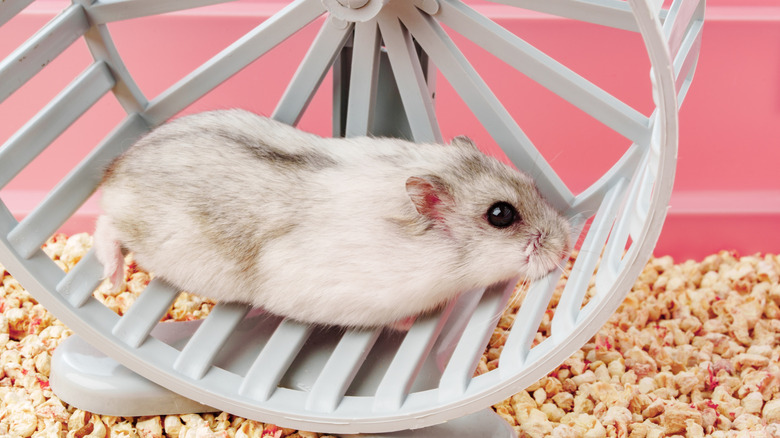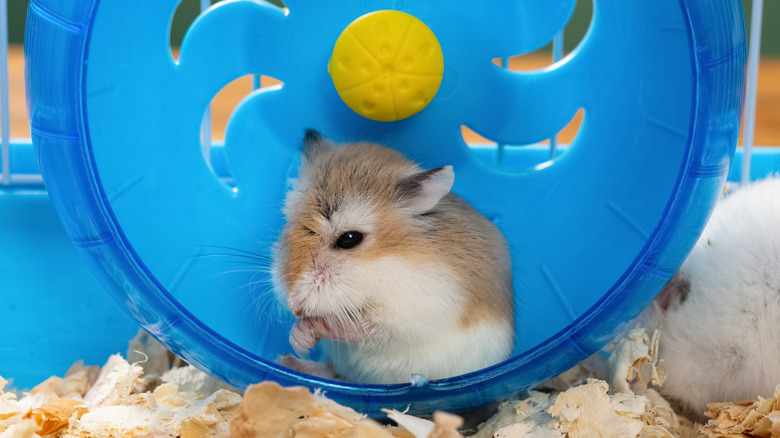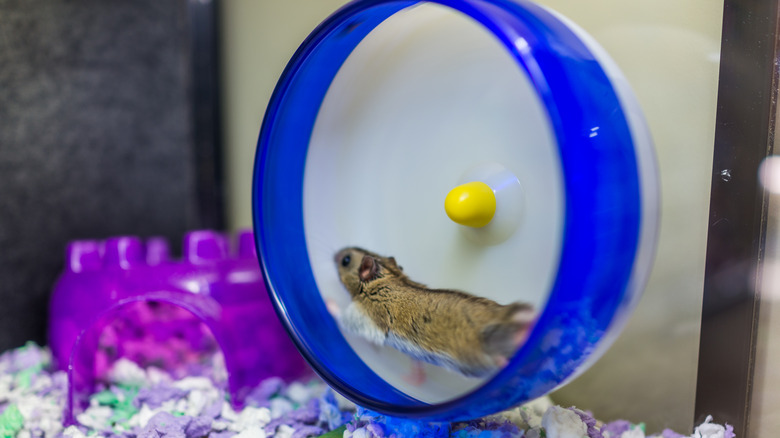You're Probably Not Washing Your Pet Hamster's Wheel Enough
We may receive a commission on purchases made from links.
Part of the charm of a pet hamster comes from their busy personalities, which includes steady grooming to help keep their coat clean and combat pests like hamster mites. The little fluffball's continued commitment to self-care may lead some owners to downplay the importance of cleaning their cages and favorite toys. However, a clean cage can help prevent skin, eye, and respiratory tract infections, which can lead to more significant and long-term issues, such as pneumonia.
A diligent owner should be looking to clean a hamster's cage weekly — or more often as needed — to keep your pet happy and healthy. This routine applies to every part of the cage. Even if the wheel doesn't seem as dirty as other areas, it still needs regular cleaning. Neglecting the wheel can lead to problems like bumblefoot, where bacterial buildup causes sore, inflamed, and infected feet. Another concern is wet tail, a condition caused by stress and bacteria that can lead to symptoms such as diarrhea and dehydration. Fortunately, keeping a hamster wheel clean is a simple way to help prevent these issues while providing a positive environment for your pet to thrive in.
The best hamster wheel materials for easier cleaning
Before considering the cleaning process, it's wise to purchase a wheel that's easy to maintain in the first place. In a Reddit thread about the best available wheel, many users recommended the plastic Niteangel Super-Silent Hamster Exercise Wheel for its straightforward cleaning process, durability, and quietness. Other vet-approved easy-to-clean plastic hamster wheels available include the Oxbow Animal Health Enriched Life Run & Hide and the Exotic Nutrition Silent Runner.
Cork or wood can be more absorbent of smells and time-consuming to clean as they need to be boiled and adequately dried. Yet, those who prefer cork for its smoothness and kindness to a hamster's joints can purchase a Niteangel Wooden Hamster Exercise Wheel with Replacement Cork Running Tracks to minimize how often they need to do a thorough clean by replacing the running surface. Metal wheels, or those with a mesh overlay, can be more difficult to clean due to their surface and do not offer a safe running surface compared to other materials.
How to clean a hamster wheel
Of all the available options, plastic is among the most popular choices for its ease of maintenance. Cleaning a plastic wheel is as simple as taking it apart, washing it in the sink (using mild dish soap and avoiding harsh chemicals), thoroughly rinsing it, and letting it dry completely to prevent harmful bacteria and mold buildup. This entire process is demonstrated in a video by YouTuber Rachel Got Hamsters:
Weekly cleaning can be challenging, especially for busy pet parents. Purchasing two wheels can help make the process easier, allowing a quick replacement if there are any interruptions to a regular cleaning schedule. A pet parent can also use baby wipes or a reusable cloth to spot-clean a wheel. However, the environmentally-conscious pet parent may want to skip the wet wipes and opt for easier-to-clean surfaces to avoid unnecessary waste.
An adequately maintained and clean sand bath for your hamster is also an ideal way to help keep your hamster, and by proxy their wheel, cleaner, lowering the chance of bacteria build-up. Regular cage cleaning, including the hamster wheel, can help prevent health issues, encourage exercise, increase longevity, and better ensure your hamster likes you.


